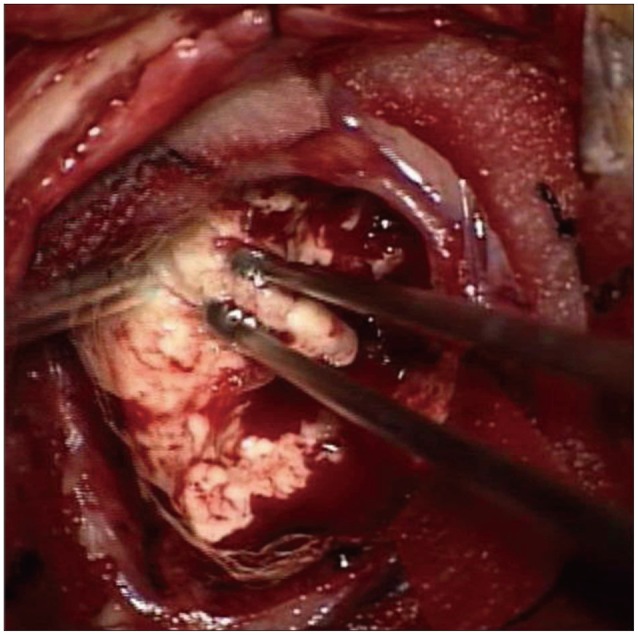J Korean Neurosurg Soc.
2014 Nov;56(5):444-447. 10.3340/jkns.2014.56.5.444.
Cerebral Phaeohyphomycosis: A Rare Cause of Brain Abscess
- Affiliations
-
- 1Department of Neurosurgery, Dongsan Medical Center, Keimyung University School of Medicine, Daegu, Korea. bach1158@dsmc.or.kr
- KMID: 2018107
- DOI: http://doi.org/10.3340/jkns.2014.56.5.444
Abstract
- Cerebral phaeohyphomycosis (CP) is a very rare but serious form of central nervous system fungal infection that is caused by dematiaceous fungi. It is commonly associated with poor prognosis irrespective of the immune status of the patient. In this study, the authors describe the first case of CP in Korea that occurred in a 75-year-old man without immunodeficiency and showed favorable outcome after surgical excision and antifungal therapy. In addition, the authors herein review the literature regarding characteristics of this rare clinical entity with previously reported cases.
MeSH Terms
Figure
Reference
-
1. Badali H, de Hoog GS, Curfs-Breuker I, Meis JF. In vitro activities of antifungal drugs against Rhinocladiella mackenziei, an agent of fatal brain infection. J Antimicrob Chemother. 2010; 65:175–177. PMID: 19854862.
Article2. Brandt ME, Warnock DW. Epidemiology, clinical manifestations, and therapy of infections caused by dematiaceous fungi. J Chemother. 2003; 15(Suppl):36–47. PMID: 14708965.
Article3. Cristini A, Garcia-Hermoso D, Celard M, Albrand G, Lortholary O. Cerebral phaeohyphomycosis caused by Rhinocladiella mackenziei in a woman native to Afghanistan. J Clin Microbiol. 2010; 48:3451–3454. PMID: 20592148.
Article4. Dixon DM, Walsh TJ, Merz WG, McGinnis MR. Infections due to Xylohypha bantiana (Cladosporium trichoides). Rev Infect Dis. 1989; 11:515–525. PMID: 2672237.
Article5. Fader RC, McGinnis MR. Infections caused by dematiaceous fungi : chromoblastomycosis and phaeohyphomycosis. Infect Dis Clin North Am. 1988; 2:925–938. PMID: 3062095.
Article6. Gongidi P, Sarkar D, Behling E, Brody J. Cerebral phaeohyphomycosis in a patient with neurosarcoidosis on chronic steroid therapy secondary to recreational marijuana usage. Case Rep Radiol. 2013; 2013:191375. PMID: 23533904.
Article7. Hauck EF, McGinnis M, Nauta HJ. Cerebral phaeohyphomycosis mimics high-grade astrocytoma. J Clin Neurosci. 2008; 15:1061–1066. PMID: 18614370.
Article8. Jabeen K, Farooqi J, Zafar A, Jamil B, Mahmood SF, Ali F, et al. Rhinocladiella mackenziei as an emerging cause of cerebral phaeohyphomycosis in Pakistan : a case series. Clin Infect Dis. 2011; 52:213–217. PMID: 21288846.
Article9. Kantarcioglu AS, de Hoog GS. Infections of the central nervous system by melanized fungi : a review of cases presented between 1999 and 2004. Mycoses. 2004; 47:4–13. PMID: 14998393.
Article10. Li DM, de Hoog GS. Cerebral phaeohyphomycosis--a cure at what lengths? Lancet Infect Dis. 2009; 9:376–383. PMID: 19467477.
Article11. Matsumoto T, Ajello L, Matsuda T, Szaniszlo PJ, Walsh TJ. Developments in hyalohyphomycosis and phaeohyphomycosis. J Med Vet Mycol. 1994; 32(Suppl):329–349. PMID: 7722796.
Article12. Ochiai H, Kawano H, Minato S, Yoneyama T, Shimao Y. Cerebral phaeohyphomycosis : case report. Neuropathology. 2012; 32:202–206. PMID: 21801237.13. Palaoglu S, Sav A, Basak T, Yalcinlar Y, Scheithauer BW. Cerebral phaeohyphomycosis. Neurosurgery. 1993; 33:894–897. PMID: 8264889.
Article14. Ravisankar S, Chander RV. Cerebral pheohyphomycosis : report of a rare case with review of literature. Neurol India. 2013; 61:526–528. PMID: 24262459.
Article16. Revankar SG, Patterson JE, Sutton DA, Pullen R, Rinaldi MG. Disseminated phaeohyphomycosis : review of an emerging mycosis. Clin Infect Dis. 2002; 34:467–476. PMID: 11797173.17. Revankar SG, Sutton DA, Rinaldi MG. Primary central nervous system phaeohyphomycosis : a review of 101 cases. Clin Infect Dis. 2004; 38:206–216. PMID: 14699452.
Article19. Rosow L, Jiang JX, Deuel T, Lechpammer M, Zamani AA, Milner DA, et al. Cerebral phaeohyphomycosis caused by Bipolaris spicifera after heart transplantation. Transpl Infect Dis. 2011; 13:419–423. PMID: 21323827.
Article20. Sharkey PK, Graybill JR, Rinaldi MG, Stevens DA, Tucker RM, Peterie JD, et al. Itraconazole treatment of phaeohyphomycosis. J Am Acad Dermatol. 1990; 23(3 Pt 2):577–586. PMID: 2170477.
Article21. Shimosaka S, Waga S. Cerebral chromoblastomycosis complicated by meningitis and multiple fungal aneurysms after resection of a granuloma. Case report. J Neurosurg. 1983; 59:158–161. PMID: 6864272.
Article22. Sood S, Vaid VK, Sharma M, Bhartiya H. Cerebral phaeohyphomycosis by Exophiala dermatitidis. Indian J Med Microbiol. 2014; 32:188–190. PMID: 24713913.
Article23. Suri P, Chhina DK, Kaushal V, Kaushal RK, Singh J. Cerebral phaeohyphomycosis due to cladophialophora bantiana - a case report and review of literature from India. J Clin Diagn Res. 2014; 8:DD01–DD05. PMID: 24959445.
Article
- Full Text Links
- Actions
-
Cited
- CITED
-
- Close
- Share
- Similar articles
-
- Brain Abscess Following Intracerebral Hemorrhage: A Case Report
- Brain Abscess Developed on the Lesion Site of Previous Ischemic Stroke
- Phaeohyphomycosis Due to Exophiala dermatitidis Successfully Treated with Itraconazole
- Brain Abscess, A Study of Eight Consecutive Cases
- A Case of Brain Abscess due to Cerebral Paragonimiasis





